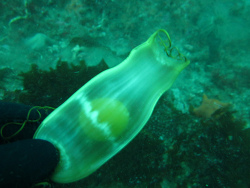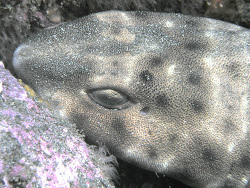Info
Cephaloscyllium ventriosum (Garman, 1880)
Cephaloscyllium ventriosum, also knon as the swell shark, is found in subtropical waters between the eastern Pacific from central California to the Gulf of California and south to southern Mexico and central Chile. This shark prefers rocky, algae-covered areas near the continental shelves and upper slopes from inshore to deeper waters up to 457 m deep, but most commonly at 5-17 m deep.
Cephaloscyllium ventriosum is a fascinating creature that gets its name for its ability to swallow large volumes of water or air when threatened, which causes the shark to double in size. It inflates its body by bending it into a U-shape while grabbing its tail fin with the mouth. Then the swell shark swallows water or air to deter the predator by its size or by swelling large enough to make pulling it from a crevice a difficult task. Afterward, the swell shark emits a bark-like noise and expels the air or water.
The swell shark feeds on bony fishes, mollusks, and crustaceans. Prey are ambushed near the bottom by the swell shark lying in wait with its mouth wide open. Victims are either sucked in or swept in by the currents.
Shark bites can be quite lethal to humans, especially the 10 most dangerous shark species are considered and can launch unprovoked attacks from humans: - Great white shark - Bull shark - Tiger shark - Sand tiger shark - Blacktip shark - Bronze shark - Spinner shark - Blue shark - Hammerhead shark - Whitetip shark The bite by a shark is one of the most basic fears of humans, but the number of deaths caused by shark attacks is very low: in 2015 there were 98 attacks by sharks and in 6 cases the attack resulted in a fatal end for humans. In 2016 there were 107 attacks by sharks and in 8 cases the attack resulted in a fatal end for humans. Sources: http://hai.ch/Hai-Infos/Unfaelle/index.html http://www.focus.de/reisen/videos/auch-urlaubsorte-betroffen-schrecklicher-rekord-2016-gab-es-mehr-hai-angriffe-als-je-zuvor_id_6519581.html http://www.spiegel.de/wissenschaft/natur/hai-angriffe-erreichen-2015-rekordhoch-weiterer-anstieg-erwartet-a-1076339.html http://www.zeit.de/2016/37/haie-toetung-tierschutz-surfer
In 2022, there were a total of 108 shark attacks in the USA.
Conversely, however, 100 million sharks were killed by humans. http://www.zeit.de/2016/37/haie-toetung-tierschutz-surfer The risk of being bitten by a shark varies greatly from region to region, with most attacks occurring in Florida, Australia and South Africa. Please be careful not to go into the water with bleeding skin wounds, heed bathing warnings from the authorities and be very careful when using surfboards, as sharks can easily confuse the boards with seals and harbour seals. After shark bites, always call a doctor or / and the rescue service as soon as possible, as heavy bleeding can be life-threatening.
https://worldanimalfoundation.org/advocate/shark-attack-statistics/
Synonymised names
Catulus uter Jordan & Gilbert, 1896 · unaccepted
Cephaloscyllium uter (Jordan & Gilbert, 1896) · unaccepted
Scyllium ventriosum Garman, 1880 · unaccepted
Cephaloscyllium ventriosum, also knon as the swell shark, is found in subtropical waters between the eastern Pacific from central California to the Gulf of California and south to southern Mexico and central Chile. This shark prefers rocky, algae-covered areas near the continental shelves and upper slopes from inshore to deeper waters up to 457 m deep, but most commonly at 5-17 m deep.
Cephaloscyllium ventriosum is a fascinating creature that gets its name for its ability to swallow large volumes of water or air when threatened, which causes the shark to double in size. It inflates its body by bending it into a U-shape while grabbing its tail fin with the mouth. Then the swell shark swallows water or air to deter the predator by its size or by swelling large enough to make pulling it from a crevice a difficult task. Afterward, the swell shark emits a bark-like noise and expels the air or water.
The swell shark feeds on bony fishes, mollusks, and crustaceans. Prey are ambushed near the bottom by the swell shark lying in wait with its mouth wide open. Victims are either sucked in or swept in by the currents.
Shark bites can be quite lethal to humans, especially the 10 most dangerous shark species are considered and can launch unprovoked attacks from humans: - Great white shark - Bull shark - Tiger shark - Sand tiger shark - Blacktip shark - Bronze shark - Spinner shark - Blue shark - Hammerhead shark - Whitetip shark The bite by a shark is one of the most basic fears of humans, but the number of deaths caused by shark attacks is very low: in 2015 there were 98 attacks by sharks and in 6 cases the attack resulted in a fatal end for humans. In 2016 there were 107 attacks by sharks and in 8 cases the attack resulted in a fatal end for humans. Sources: http://hai.ch/Hai-Infos/Unfaelle/index.html http://www.focus.de/reisen/videos/auch-urlaubsorte-betroffen-schrecklicher-rekord-2016-gab-es-mehr-hai-angriffe-als-je-zuvor_id_6519581.html http://www.spiegel.de/wissenschaft/natur/hai-angriffe-erreichen-2015-rekordhoch-weiterer-anstieg-erwartet-a-1076339.html http://www.zeit.de/2016/37/haie-toetung-tierschutz-surfer
In 2022, there were a total of 108 shark attacks in the USA.
Conversely, however, 100 million sharks were killed by humans. http://www.zeit.de/2016/37/haie-toetung-tierschutz-surfer The risk of being bitten by a shark varies greatly from region to region, with most attacks occurring in Florida, Australia and South Africa. Please be careful not to go into the water with bleeding skin wounds, heed bathing warnings from the authorities and be very careful when using surfboards, as sharks can easily confuse the boards with seals and harbour seals. After shark bites, always call a doctor or / and the rescue service as soon as possible, as heavy bleeding can be life-threatening.
https://worldanimalfoundation.org/advocate/shark-attack-statistics/
Synonymised names
Catulus uter Jordan & Gilbert, 1896 · unaccepted
Cephaloscyllium uter (Jordan & Gilbert, 1896) · unaccepted
Scyllium ventriosum Garman, 1880 · unaccepted







 AndiV
AndiV








